How To Care For An Indoor Bonsai
Bringing a bonsai into your home is a lot more important than you might think. We primarily choose easy plants when we’re looking to add greenery and vegetation into our interior decorating arsenal; plants that are easy to take care of. Bonsai is distinctly different. This is a plant that requires a lot more attention than any potted fern or elephant ear. But it also has a much larger overall benefit to your lifestyle.
When you bring a bonsai into your house, you’re embarking on a journey of self-improvement. A bonsai is a natural element that carries the right energy to encourage you to pay more attention to responsibility and the creative crevices of your personality. You also reap the benefits of being in closer proximity to nature, even though you may be sitting in your own living room.
There are however guidelines to pay attention to when selecting a bonsai for the home. In the article below, we’ll discuss the best practices to exercise when bringing a bonsai into your most sacred sanctuary – your home.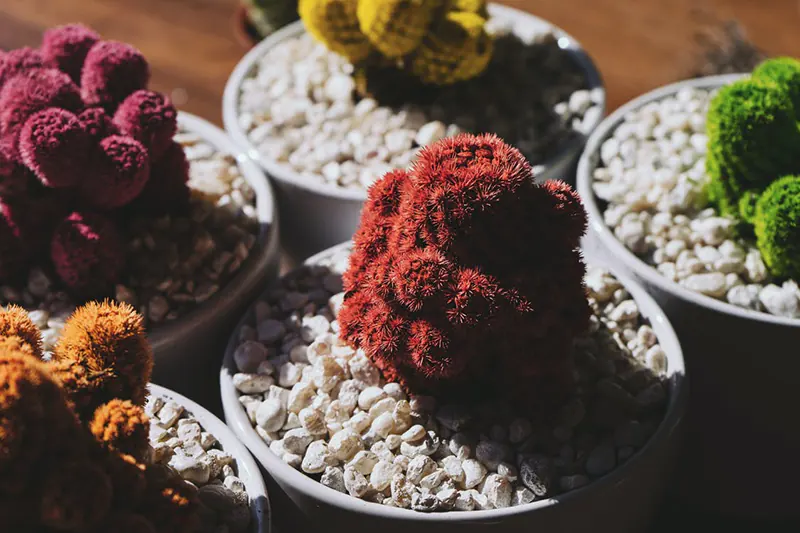
A Tale of Two Trees
To clarify, contrary to the so-called expertise of other bonsai blogs, there isn’t one type of tree that makes a better indoor bonsai than another. By type of tree, we mean whether the tree natively grows in a tropical or temperate region. As a bonsai or general horticultural enthusiast, we can assume that you want your plant babies to have the best chance to thrive. Therefore, if you want to include bonsais in your interior decorating or Fengshui arsenal, you should suit your bonsai to your interior climate. Alternatively, you can simulate an interior climate suited to a particular type of tree.
Now that we’ve shattered preconceived notions and the perpetuation of falsehoods within the bonsai enthusiast sphere, let’s discuss climate and suitability more thoroughly. It’s important to remember that there’s a vast difference in the way that each horizontal band of the earth – divided by the lines of latitude – experiences seasons. In general, the closer you are to the equator, the warmer your average temperatures will be and the less of a leap there is between summer temperatures and winter temperatures.
If you’re situated further from the equator, however, especially south of the tropic of Capricorn and north of the tropic of Cancer, you’ll likely experience cooler summer temperatures and far harsher winters. Wherever you find yourself, you’ll notice that the vegetation in your region is mostly suited to thrive under those particular conditions. For example, tropical bonsai trees will do better indoors in tropical and sub-tropical climates due to the higher humidity and warmth requirements that these climates meet. While there’s certainly a difference in temperature from summer to winter, the tropical climate is overall warm and humid year-round.
Even though the climate is primarily important if you want to plant a bonsai in a pot outdoors, your climate influences indoor temperatures as well as factors like sunlight and humidity. The interiors of houses on the Mediterranean coast, for example, are still warmer and more humid than the interior of a house in Alaska.
Because there is such a clear disparity between the requirements of tropical and temperate bonsai varieties, we don’t want to give a highly specified guide on how to care for one particular type of indoor bonsai. Instead, we’re going to furnish you with all the information you may need – plus a few quick tips – and let you adapt that information to your particular plant. 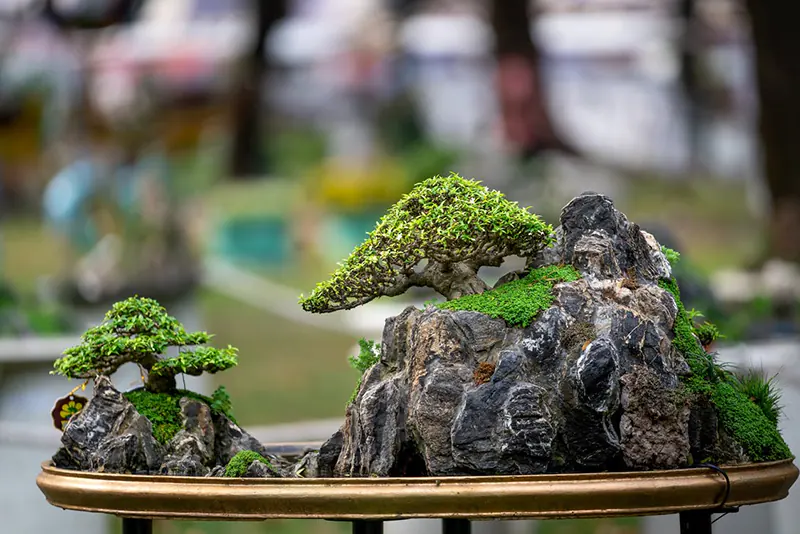
Caring for Any Indoor Bonsai Tree
Keeping bonsais alive isn’t rocket science. As with any plant, you simply need to meet your bonsais light, humidity, water, fertilization, and air requirements. As previously mentioned, you need to be aware of the needs that your bonsai will not equivocate on. Alternatively, you need to simulate an internal environment that furnishes your bonsai with everything that it needs.
We’ll tackle these requirements one by one in an easily digestible short format for maximum retention. 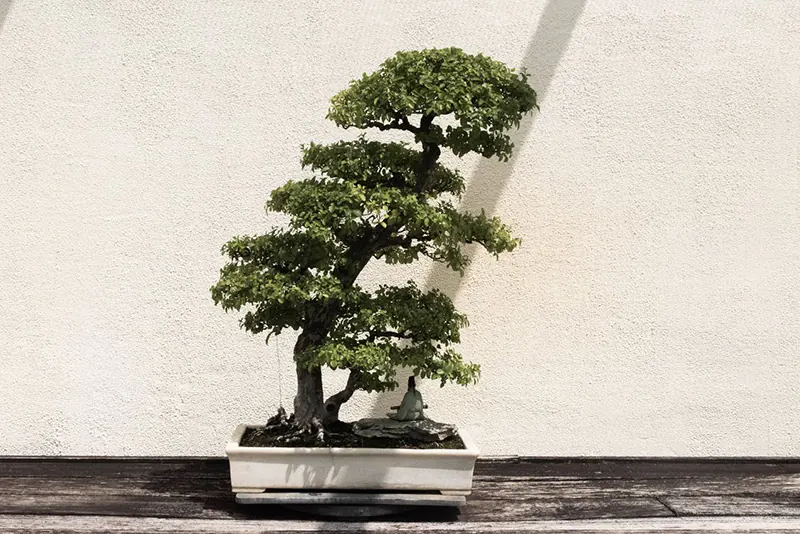
Light
This is one of the most important requirements of any plant. Without sufficient light, your bonsai will not be able to photosynthesize. It will therefore not be able to produce the nutrients that it needs and it will eventually die. In the case of tropical bonsais, ensure that the plant receives at least 12-14 hours of sunlight each day. Seeing as your bonsai is an indoor plant, you need to make sure that whichever location you choose for it receives the right amount of light. This sounds like a lot of sunlight, and many houses simply don’t have the ability to provide optimal sun-drenched locations. However, you may be overestimating what 12 hours of sunlight realistically means.
Here’s a really cool way to tell if your plant will receive sufficient light in any given space:
All you need for this is your hand, a room, and a blank sheet of paper. Take your sheet of paper to the surface where you’d like to place your indoor bonsai and set it down. Hold your hand around 6 inches above the sheet of paper and observe the shadow that your hand casts. If the shadow is crisp and clearly defined, you have a sufficiently bright light. If the shadow is present, but fuzzy with unclear edges, you have medium light. If, however, you have a very faint shadow or none at all, you don’t have enough light for flowering.
If, like me, you’re a frequent face at your local nursery, you’ll know of the little tags they put on each plant that tell you how much light your plant needs. Typically, plants will be categorized as either needing full-sun, partial-sun, or shady conditions. How convenient that the white paper method integrates perfectly with these categories! If you don’t have a little tag for your bonsai, you can check its particular light requirements on the internet. From there, it’s easy to determine whether your bonsai will receive enough light:
- If the shadow that your casts is clear and crisp, you have the perfect condition for a bonsai that needs full sun.
- If the your hand’s shadow is fuzzy, you’ve found the ideal spot for a bonsai that requires partial-sun.
- If there is little to no shadow cast on the paper, pick a new spot because very few plants thrive in 90-100% shady conditions.
Quick tip: If you’re looking for a bonsai for your living room or any other area of your house that typically doesn’t experience sun, try the Ficus eslastica, or Rubber Tree Bonsai. In fact, many of the species within the ficus family need very little to no direct sunlight to grow perfectly well. 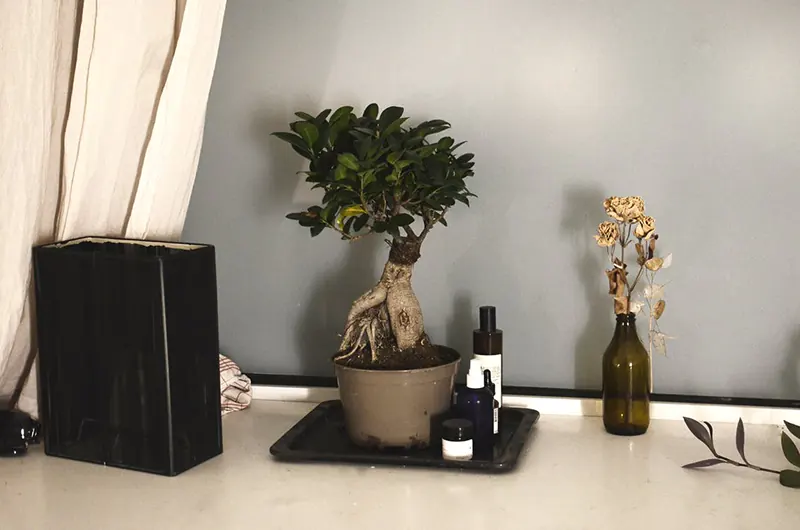
Humidity
Humidity is a factor many garden enthusiasts scarcely think about. When I was first starting out, I had little awareness of what humidity actually was and no frame of reference in terms of how important it is to plants. Humidity is a measure of how much water vapor there is in the air. If there is a lot of water vapor in the air, the humidity will be higher. If the humidity is higher, the air will feel damper than on a less humid day.
The ideal humidity for most indoor bonsai trees is 40-50%. This changes to a degree whether you’re considering a tropical or temperate bonsai. In general, a tropical bonsai tree such as those cultivated from Hibiscus rosa-Sinensis or Bougainvillea glabra will require more humidity due to the humid conditions of the tropical regions to which they are native. On the other hand, temperate trees such as the magnificent cherry blossom will require less humidity.
There are luckily ways in which you can control the humidity that your bonsai is exposed to. If you need to increase the humidity levels that your bonsai experiences, you can simply mist your bonsai a few times each day. Note that misting doesn’t mean spraying your bonsai with so much water that it ends up drowning. All you want to do is just spray a fine mist in your bonsai’s direction to simulate the conditions of a more humid day.
If you don’t want to be misting your bonsai every so often, you could almost invest in a humidity tray upon which to rest your bonsai. Here, all you need to do is fill the humidity tray with water and let it do its thing. For better results, open the nearest window to increase air circulation and therefore help your bonsai meet the perfect humidity levels it requires to live happily indoors.
If for any reason, you need to decrease the humidity levels in your home, you can try opening more windows to increase the flow of cool air. You should also do simple things like keep surfaces dry, not boil water too often, and run cooler showers and baths. You could also invest in a dehumidifier or grow plants that absorb humidity. There isn’t really a likely scenario in which you’ll need to decrease humidity levels to keep a bonsai alive, but should you ever need to, now you know how to do it. 
Water
This is another factor that is subject to change depending on the type of bonsai you intend to bring into your home. Your primary objective should not be meeting the requirements of the average bonsai – although we’ll mention those specifics for you in a moment. You should be meeting the watering requirements of whichever plant you have cultivated as a bonsai. For instance, if your bonsai is a money tree, familiarize yourself first with the watering requirements of the money tree. Remember, each bonsai is different and may have different requirements for thriving.
That said, here is a generalized and basic guide for how to water a bonsai:
- You should water your bonsai every four to seven days.
- You should never let your bonsai dry out completely as this can be fatal.
- You can test whether your bonsai needs water by pressing your finger one inch deep into your bonsai’s soil. If the soil around your finger is dry, it is likely time to water.
- On average, you should water only enough to soak your bonsai’s root system. You can do this in two ways. Either water your bonsai from overhead and wait for the water to seep out of the drainage holes, or place your bonsai into a tray of water to immerse the roots from the bottom.
Watering a bonsai is generally really easy. Still, a lot of newcomers to the bonsai enthusiast lifestyle fear that they will overwater their bonsai. This is a good thing to be aware of, but not necessarily something you need to fear.
Your bonsai will let you know when you are giving it too much water. Keeping to the watering guidelines is a way to circumvent this, but here are a few ways in which your bonsai will tell you that it is receiving water too frequently, or simply receiving too much water:
- Look out for soil that is constantly wet. This is a good sign that you are overwatering your bonsai.
- Keep an eye on your bonsai’s leaves. If they change color, go limp, or start to fall off, this may be an indication of overwatering.
- If the branches on your bonsai seem to get weaker and the trunk becomes less stable and able to support the weight of the tree, you’re likely overwatering your bonsai.
Any of these changes can also serve as evidence of root rot. In the case of root rot, you’ll need to:
- Remove your bonsai carefully from its pot.
- Clean off the soil and mud so that you can see what’s going on with the root system and determine the extent of the root rot.
- Trim off the damaged pieces of root, taking care not to remove too much of the root system.
- Allow your bonsai’s roots to dry out a little. You don’t want them to die completely, but you do want them to have a chance to recover from being waterlogged.
- Repot your bonsai in fresh dry soil and resume normal waterings.
You don’t need to be paranoid about your bonsai and try to keep to a rigid, strict watering schedule. But you do need to at least be aware of what your plant may be trying to communicate to you through the means it has at its disposal.
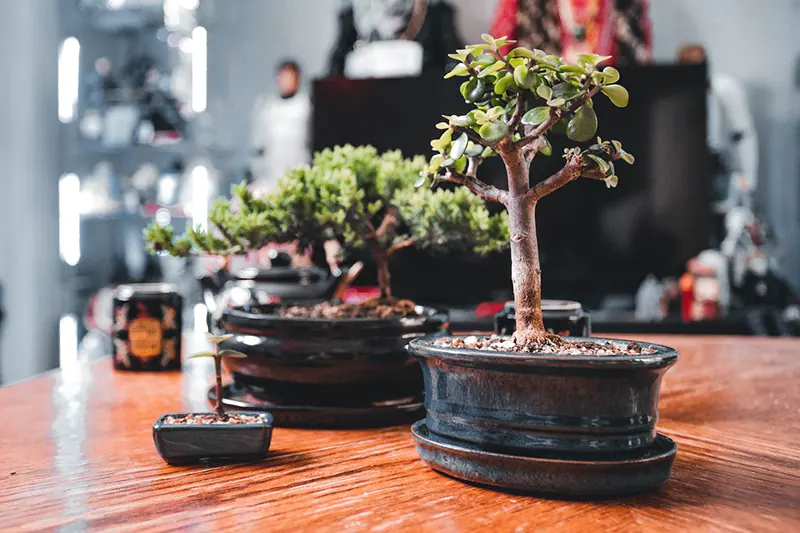
Fertilization
This is the one factor that has little to do with your bonsai tree species, and more to do with the fact that it is a bonsai and is being intentionally grown in a smaller and more compact format. Instead of using Bougain fertilizer for bougainvillea or hibiscus bonsai, for instance, you’ll use a dedicated bonsai fertilizer.
Fertilizing a bonsai is simple and easy to do successfully. You will, however, need to know whether your tree is deciduous or not.
Keep your fertilizing activity localized to active growing seasons. These are summer and spring. As with any plant, you don’t want to give your bonsai fertilizer during dormant months as this can result in nitrogen burn, frail foliage, and eventually death. During summer and spring, you should fertilize your bonsai every two weeks. You can still apply fertilizer to your bonsai during fall, but keep this to only twice during this season. Don’t fertilize in winter. For deciduous trees, you’ll want to wait for the leaves to start opening up again in spring before resuming normal fertilizing activity.
You’ll also want to keep the age of your tree in mind. In general, older, more mature trees don’t get fertilized as often as younger, more supple trees.
Food for thought: It can take a short while to get accustomed to the fertilizer routine of a bonsai tree, but eventually, processes like this become more muscle memory than conscious thought. This is therefore a brilliant way to train the human mind to accept new, better habits.
Air
This is another factor that few ever pay attention to when deciding on where to place their bonsais indoors. Air is one of the four elements – the others being water, fire, and earth – that a plant like a bonsai tree needs to survive and thrive. Water is self-explanatory. Bonsais are typically planted in the earth, or a pot containing earth. Fire is a seemingly dangerous element to bring into contact with a living organism, but bonsais get the benefit of elemental fire through the heat and light of the sun. Air is technically all around bonsais at all times, but the quality of air is what makes the biggest difference.
You need your bonsai to be in a place where it can experience sufficient airflow. This does not mean a strong gust of wind as this could be the end of your bonsai, its leaves, and even its branches. However, you do want your bonsai to be exposed to air that isn’t stagnant. While plants can do wonders for the quality of the air that we breathe in, they also require sufficient oxygen levels in order to sustain their critical biological systems. Without oxygen, and thus air, your bonsai will die.

Indoor Bonsais are Easy as Pie
We here at the Bonsai Alchemist, I, in particular, put a great deal of emphasis on the importance and spiritual significance of this ancient and noble Japanese art form. Even though all of our articles about the importance of a balance of masculine and feminine energy when corresponding a bonsai tree to its display pot, the significance of color and placement when including bonsai in interior decorating, and the histories of various bonsai trees are based in ancient truths and the knowledge of sacred principles, bonsais are far easier than some of our more complex articles can sometimes make them seem.
You don’t need to be a rocket scientist to understand how to keep an indoor bonsai alive and thriving. All you need is a little common sense, a little patience, and a little commitment to looking after the needs of another living organism in addition to your own. Unfortunately, we can’t furnish you with any of these directly. However, we can give you access to industry-leading information and conversation about bonsais that can further develop your common sense on the subject.
We can also converse with you through our articles about the history of bonsai, its spiritual significance in the ancient and modern worlds, and its place within movements like Zen, Fengshui, and Jodo, to try and encourage you to approach this subject and the miniature trees themselves with a little more patience. We can also tell you about our own experiences with bonsai trees and what that commitment looks like in our lives, as well as give you a better, more comprehensive understanding of their needs and base requirements, to try and encourage the kind of love toward these trees within yourself that we hold for them.
After all, the best part of developing any kind of knowledge, in my opinion, is the ability to share that knowledge, the emotions, and the responses and sensory experiences associated therewith, with other human beings.
As a final, final word, if you’re ever in need of information regarding a specifi speices of bonsai tree, our website is a vast repository of bonsai-related knowledge put together by true enthusiasts of what the Bonsai Alchemist stands for.
If ever you have any questions or queries concerning bonsais and how to keep them surviving and thriving, don’t hesitate to start a conversation with us, either here on the website, or over on our numerous social media platforms. We enjoy every minute writing about these trees and, hopefully, inspiring more people to see them for the miniature marvels of a bygone world that they are.







